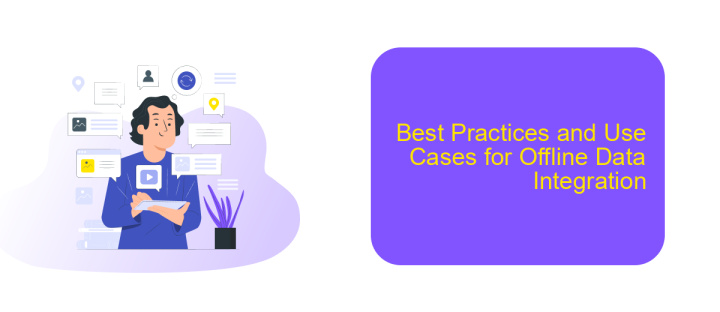Offline Data Integration
Offline data integration refers to the process of combining and harmonizing data from various sources without requiring real-time connectivity. This approach is essential for organizations that need to consolidate historical data, perform batch processing, and ensure data consistency across different platforms. By leveraging offline integration techniques, businesses can enhance their data analytics capabilities and support informed decision-making.
Introduction to Offline Data Integration
Offline Data Integration refers to the process of consolidating data from various sources that are not continuously connected to the internet. This method is particularly useful for organizations that deal with large volumes of data, which can be processed and integrated during off-peak hours to reduce network load and enhance performance.
- Batch Processing: Data is collected and processed in large volumes at scheduled intervals.
- Data Warehousing: Centralized storage where data from different sources is integrated and analyzed.
- ETL (Extract, Transform, Load): A process that involves extracting data from various sources, transforming it into a suitable format, and loading it into a target database.
Services like ApiX-Drive can facilitate offline data integration by automating the extraction, transformation, and loading processes. This not only saves time but also ensures data accuracy and consistency. By leveraging such tools, organizations can seamlessly integrate data from multiple sources, enabling more informed decision-making and efficient data management.
Challenges and Limitations of Offline Data Integration

Offline data integration presents several challenges and limitations that organizations must navigate. One primary challenge is data latency, as offline integration processes data in batches rather than in real-time. This delay can lead to outdated information, which may affect decision-making and operational efficiency. Additionally, data consistency becomes an issue when integrating data from multiple sources, as discrepancies and conflicts may arise that require manual resolution, increasing the workload and potential for errors.
Another significant limitation is the complexity of setting up and maintaining offline data integration systems. These systems often require specialized knowledge and resources to configure and manage, which can be a barrier for smaller organizations. Tools like ApiX-Drive can help mitigate some of these challenges by offering user-friendly interfaces and automated workflows that simplify the integration process. However, even with such tools, the initial setup and ongoing maintenance can still be resource-intensive, making it crucial for organizations to weigh the benefits against the costs.
Benefits and Advantages of Offline Data Integration

Offline data integration offers numerous benefits for businesses looking to streamline their operations and enhance data accuracy. By integrating data offline, companies can ensure that their data is consistent and up-to-date across various platforms without relying on continuous internet connectivity. This method is particularly useful for organizations operating in areas with limited or unreliable internet access.
- Data Consistency: Offline integration ensures that all data sources are synchronized, reducing discrepancies and improving data reliability.
- Enhanced Security: Offline processes minimize the risk of data breaches as data is not constantly transmitted over the internet.
- Cost Efficiency: Reducing the need for continuous online data transfer can lower operational costs.
- Improved Performance: Offline integration can lead to faster data processing as it is not dependent on internet speed.
- Flexibility: Tools like ApiX-Drive facilitate offline data integration, allowing businesses to customize and automate their workflows efficiently.
Incorporating offline data integration can significantly enhance an organization's data management capabilities. With solutions like ApiX-Drive, businesses can easily set up and manage their integrations, ensuring seamless data flow and operational continuity even in challenging environments. This approach not only boosts productivity but also provides a robust framework for handling data securely and efficiently.
Best Practices and Use Cases for Offline Data Integration

Offline data integration is essential for organizations that need to consolidate data from various sources without the need for real-time processing. One of the best practices is to ensure data consistency and accuracy by regularly scheduling data synchronization tasks. This helps in maintaining up-to-date information across all platforms.
Another important aspect is to choose the right tools and services that facilitate seamless offline data integration. ApiX-Drive, for instance, is a robust platform that allows businesses to automate data transfers between different systems, ensuring data integrity and reducing manual errors.
- Regularly schedule data synchronization tasks
- Choose reliable tools like ApiX-Drive for automation
- Ensure data consistency and accuracy
- Monitor and audit data integration processes
Use cases for offline data integration include consolidating sales data from various offline stores, integrating customer information from multiple databases, and synchronizing inventory data across different warehouses. By following these best practices and leveraging tools like ApiX-Drive, businesses can achieve efficient and reliable offline data integration.


Future Trends and Advancements in Offline Data Integration
As technology continues to evolve, offline data integration is poised for significant advancements. One emerging trend is the use of machine learning algorithms to automate data mapping and transformation processes. This reduces the need for manual intervention and increases the accuracy and speed of data integration. Additionally, the rise of edge computing allows for real-time data processing closer to the source, minimizing latency and enhancing the efficiency of offline data integration.
Another notable trend is the growing adoption of no-code and low-code platforms, such as ApiX-Drive, which simplify the process of setting up and managing data integrations. These platforms enable businesses to connect disparate data sources without requiring extensive technical expertise. Furthermore, advancements in data encryption and security protocols ensure that offline data integration remains secure, protecting sensitive information from potential breaches. As these trends continue to develop, they will undoubtedly shape the future landscape of offline data integration, making it more accessible, efficient, and secure.
FAQ
What is offline data integration?
Why is offline data integration important?
How can I automate offline data integration processes?
What are the challenges associated with offline data integration?
Can I use ApiX-Drive for offline data integration?
Apix-Drive is a simple and efficient system connector that will help you automate routine tasks and optimize business processes. You can save time and money, direct these resources to more important purposes. Test ApiX-Drive and make sure that this tool will relieve your employees and after 5 minutes of settings your business will start working faster.

